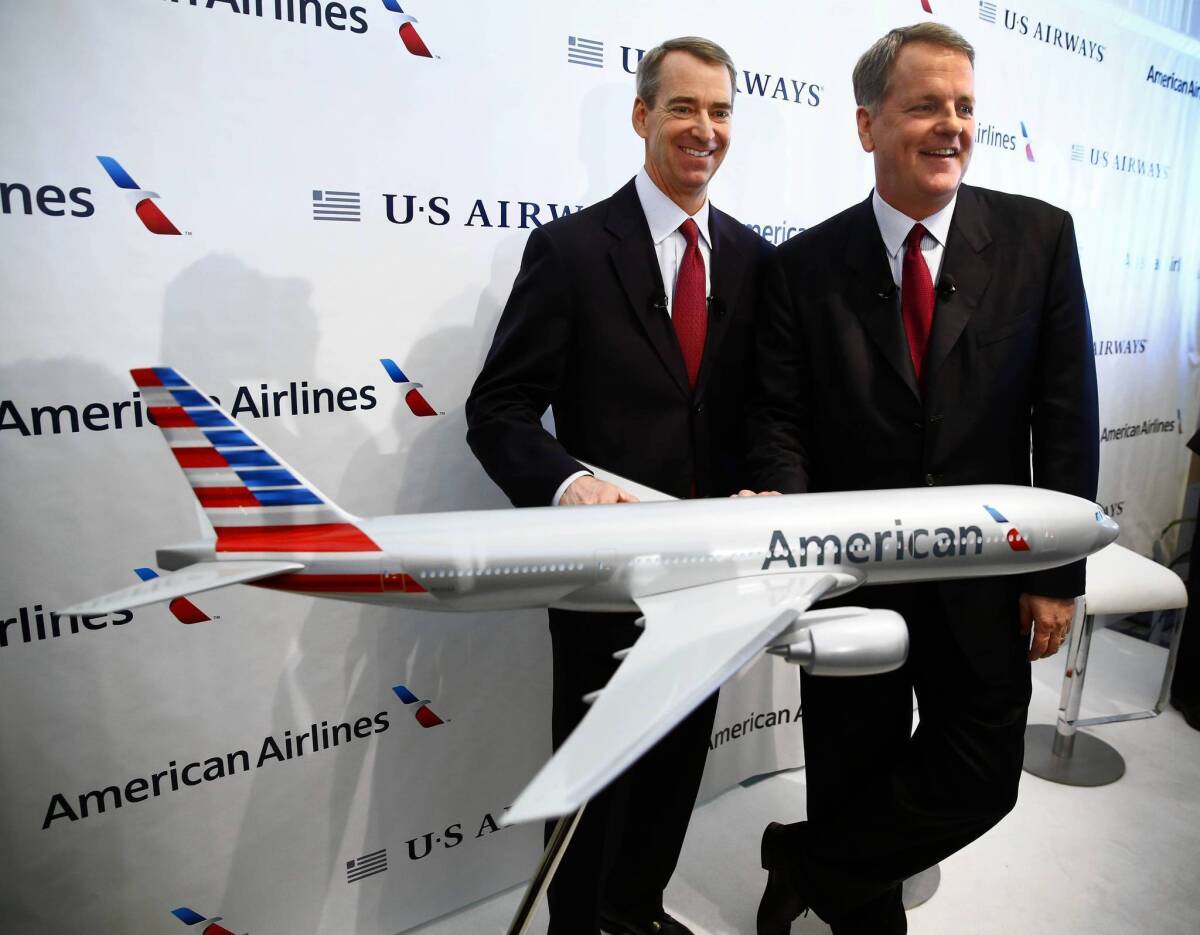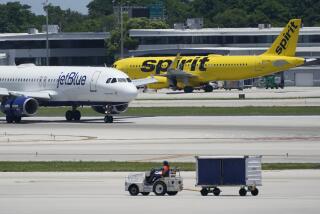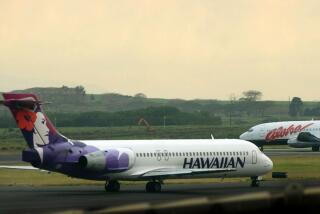American Airlines, US Airways face big hurdles in merger

- Share via
The combination of American Airlines and US Airways will create the world’s largest airline. And, if critics are to be believed, it will also cause world-class headaches for customers.
If previous airline mergers are any guide, melding the two carriers into a behemoth with more than 100,000 employees is likely to lead to reservation glitches, union tension, higher fares and cuts in service to smaller, less-profitable cities.
During the announcement of the $11-billion deal Thursday, chief executives of US Airways and American promised an idyllic marriage that will benefit consumers and shareholders. But many experts and travelers, already frustrated by how expensive and time-consuming air travel has become, are dubious.
If the merger is approved, the number of major U.S. carriers would drop from 10 in 2001 to just four — American, United, Delta and Southwest — serving about 80% of the market.
“It’s scary,” said Jann Blesener, who was at Los Angeles International Airport with her husband, Jack, returning from a trip to Kuala Lumpur back to their home in Phoenix. “There’s already not enough choices and I’m worried that prices are going to go up. You cut the competition and prices always go up.”
The deal is the latest in a series of mergers over the last decade as struggling airlines try to stay airborne in an industry contending with fluctuating fuel costs, labor strife and severe economic turbulence.
No recent airline merger has been pulled off without a glitch.
US Airways merged with America West in 2005 but has yet to get the pilots from the two airlines to agree on a common contract.
“Merging employees from three different legacy airlines — US Airways, America West and American — would be complicated and very likely result in higher labor costs,” according to an analysis by ratings company Standard & Poor’s.
When United Airlines and Continental Airlines combined their reservation systems last year, dozens of United flights were delayed because of computer errors, apparently resulting from efforts to switch over to the reservation system formerly used by Continental.
American and US Airways officials say the frequent flier points from each airline will be honored by the newly merged carrier. But passengers and analysts fear problems could arise when the programs are combined.
George Hoffer, a professor of transportation economics at the University of Richmond, said breakdowns were inevitable, regardless of the best planning and intentions of airline executives.
“Don’t look at what they say, look at what they do after the merger,” he said. “You will say anything to get the merger through.”
Now that the American-US Airways deal has been announced, it could take about seven months to draw up the paperwork, get regulatory approval and create a new management team and board of directors. But consolidating the two airlines into one carrier, under the name American, could take far longer.
American’s parent company, AMR Corp., filed for bankruptcy in 2011, and the merger must be approved by the Bankruptcy Court. The US Airways headquarters in Tempe, Ariz., must be moved to Fort Worth, Texas, where American now operates it headquarters.
At LAX, where American operates out of Terminal 4 and US Airways flies out of Terminal 1, the two airlines must consolidate to one terminal. It’s a task neither airline has started to plan.
The maintenance shops must gear up for a different assortment of aircraft. American Airlines’ fleet of 617 jets is dominated by aircraft built by Chicago-based Boeing, whereas most of US Airways’ 341 planes were built by European-based Airbus. Both American and US Airways operate fleets that are two to five years older than the average in the industry.
Merging the reservation and frequent flier systems could be another arduous task.
“It’s going to be a huge challenge, merging hardware, software and data,” said Bill Curtis, a senior vice president at New York-based CAST, a software analysis company. “If they can do it in months, they are geniuses.”
Still, American and US Airways officials portrayed the deal as a win-win for the airlines and passengers.
“This combination is the best path forward,” said US Airways Chief Executive Doug Parker, who will take over as CEO of the new airline. AMR CEO Thomas Horton will be non-executive board chairman. “Our two networks are extremely complementary.”
Analysts have pointed out that American and US Airways complement each other in many ways. American dominates in larger airports, with more robust International service, while US Airways has focused on mid-size cities along the East Coast. The two carriers compete head to head in only about a dozen routes.
Some experts say the number of major airlines remaining in the U.S. still assures healthy competition.
“Any more consolidation has the potential to upset the dynamic of marketplace competition and airline ticket prices,” said Tom Captain, principal and vice chairman of Deloitte’s aerospace and defense practice. “The creation of a mega-carrier allows airlines to bring down internal costs.”
The unions for pilots, flight attendants and ground crews for the two airlines have already reached tentative agreements for working at the merged airline.
“Flight attendants from both companies are eager to help build a strong and competitive airline and restore American’s prominence,” said Laura Glading, president of the Assn. of Professional Flight Attendants, the union for American Airlines attendants.
Officials from the two airlines also promise not to make the same mistakes made during previous mergers.
“No lesson is too small,” said Andrew Nocella, senior vice president of planning and marketing for US Airways. “We have studied what competitors have done, what went well and what didn’t go well.”
W.J. Hennigan contributed to this report.
More to Read
Inside the business of entertainment
The Wide Shot brings you news, analysis and insights on everything from streaming wars to production — and what it all means for the future.
You may occasionally receive promotional content from the Los Angeles Times.











